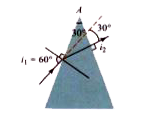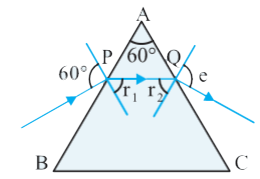A ray of light is incident at an angle of on the face of a prism having refracting angle The ray emerging out of the prism makes an angle with the incident ray. Show that the emergent ray is perpendicular to the face through which it emerges and calculate the refractive index of the material of prism.
The correct Answer is:C
To solve the problem step by step, we will follow the given information and apply the principles of refraction and geometry of the prism.
Step 1: Identify the given values
- Angle of incidence (I1) = 60°
- Refracting angle of the prism (A) = 30°
- Angle of deviation (δ) = 30° (since the emergent ray makes an angle of 30° with the incident ray)
Step 2: Use the formula for angle of deviation
The angle of deviation (δ) for a prism can be expressed as:
δ=I1+I2−A
Where:
- I2 is the angle of refraction at the second face of the prism.
Step 3: Substitute the known values into the deviation formula
Substituting the known values into the equation:
30°=60°+I2−30°
Step 4: Solve for I2
Rearranging the equation:
30°=60°+I2−30°
30°=30°+I2
I2=0°
Step 5: Interpret the result for I2
Since I2=0°, this means that the ray emerges without bending at the second face of the prism. Therefore, the emergent ray is perpendicular to the face through which it emerges.
Step 6: Use Snell's Law to find the refractive index
According to Snell's Law:
μ1sinI1=μ2sinI2
Where:
- μ1 is the refractive index of air (approximately 1),
- μ2 is the refractive index of the prism material.
Substituting the known values:
1⋅sin(60°)=μ⋅sin(30°)
Step 7: Substitute the sine values
Using the values:
- sin(60°)=√32
- sin(30°)=12
The equation becomes:
1⋅√32=μ⋅12
Step 8: Solve for μ
Rearranging gives:
μ=√3212=√3
Conclusion
The refractive index of the material of the prism is √3.
---
- Angle of incidence (I1) = 60°
- Refracting angle of the prism (A) = 30°
- Angle of deviation (δ) = 30° (since the emergent ray makes an angle of 30° with the incident ray)
The angle of deviation (δ) for a prism can be expressed as:
δ=I1+I2−A
Where:
- I2 is the angle of refraction at the second face of the prism.
Substituting the known values into the equation:
30°=60°+I2−30°
Rearranging the equation:
30°=60°+I2−30°
30°=30°+I2
I2=0°
Since I2=0°, this means that the ray emerges without bending at the second face of the prism. Therefore, the emergent ray is perpendicular to the face through which it emerges.
According to Snell's Law:
μ1sinI1=μ2sinI2
Where:
- μ1 is the refractive index of air (approximately 1),
- μ2 is the refractive index of the prism material.
1⋅sin(60°)=μ⋅sin(30°)
Using the values:
- sin(60°)=√32
- sin(30°)=12
1⋅√32=μ⋅12
Rearranging gives:
μ=√3212=√3
The refractive index of the material of the prism is √3.
Topper's Solved these Questions
- REFRACTION OF LIGHTBOOK - DC PANDEYCHAPTER - REFRACTION OF LIGHTEXERCISE - Level 1 Assertion And Reason
13 Videos
- REFRACTION OF LIGHTBOOK - DC PANDEYCHAPTER - REFRACTION OF LIGHTEXERCISE - Level 1 Objective
38 Videos
- REFRACTION OF LIGHTBOOK - DC PANDEYCHAPTER - REFRACTION OF LIGHTEXERCISE - Exercise 31.7
2 Videos
- REFLECTION OF LIGHTBOOK - DC PANDEYCHAPTER - REFLECTION OF LIGHTEXERCISE - Subjective
9 Videos
- SEMICONDUCTORSBOOK - DC PANDEYCHAPTER - SEMICONDUCTORSEXERCISE - Subjective
12 Videos
Similar Questions
A ray of light is incident at an angle of 60° on one face of a 30∘) prism. The emergent ray from the prism makes an angle of 30∘ with the incident ray. Show that the emergent ray is normal to the surface from which it emerges. Calculate the refractive index of the material of the prism.

View SolutionA ray of light is incident at an angle of 60∘ on one face of a prism which has refracting angle of 30∘ . The ray emerging out of the prism makes an angle of 30∘ with the incident ray. If the refractive index of the material of the prism is μ=√a , find the value of a .
View Solution
Knowledge Check
A ray of light is incident at an angle of 60∘ on one face of a prism of angle 30∘. The ray emerging out of the prism makes an angle of 30∘ with the incident ray. The emergent ray is
ANormal to the face through which it emergesBInclined at 30∘ to the face through which it emergesCInclined at 60∘ to the face through which it emergesDNone of theseA ray of light is incident at an angle of 60∘ on one face of a prism of angle 30∘. The ray emerging out of the prism makes an angle of 30∘ with the incident ray. The emergent ray is
A0∘B90∘C30∘D45∘A ray of light is incident at an angle of 60∘ on one face of a 30∘ prism . The emergent ray from the prism makes an angle of 30∘ with the incident ray. The angle of emergence and refractive index of the material of the prism are-
A90∘,√3B0∘,√3C0∘,√2D90∘,√2
A ray of light is incident at an angle of 60∘ on a prism whose refracting angle is 30∘ . The ray emerging out of the prism when produced backward makes an angle of 30∘ with the incident ray produced forward. Find the refractive index of the material of the prism.
View SolutionA Ray of light is incident at an angle 60° on one face of a prism which has protecting angle of 30°. The emerging ray deviates through 30° from incident light. The refractive index of material of prism is
View SolutionA ray of light is incident on one face of a prism (m=√3) at an angle of 60∘. The refracting angle of the prism is also 60∘. Find the angle of emergence .

View SolutionA ray of light is incident at an angle of 60∘ on one face of a prism of angle 30∘. They ray emerges normally from the other face of the prism. The refractive index of the prism material is
View SolutionA ray of light is incident at an angle of 60∘ on the face of a prism with an angle of 60∘. Then the refractive index of the material of the prism is (the prism is in minimum deviation position)
View Solution
